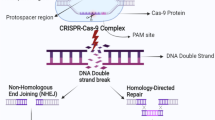Abstract
The genome of Schistosoma mansoni, a human blood fluke, contains a family of short repetitive DNA elements which we have named the SMα family. In this paper we report the sequences of two SMα family members which are derived from tandem arrangements and four family members which are dispersed copies. The two tandemly repeated copies are 331 and 335 bp, while the four dispersed copies range in size from 107 to 322 bp. Three dispersed copies are flanked by direct repeats and have AT-rich 3′ ends. The tandem copies and one of the dispersed copies have regions of homology to RNA polymerase III promoters and arginine tRNA genes. In addition the repeated element is rearranged in two of the dispersed copies when compared with the other dispersed and two tandem copies. Localization studies show that SMα elements are distributed in the sex and autosomal chromosomes. These observations suggest that members of this family may have been dispersed throughout the genome via RNA intermediates.
Similar content being viewed by others
References
Adams DS, Eickbush TH, Herrera RJ, Lizardi PM (1986) A highly reiterated family of transcribed oligo(A)-termmated, interspersed DNA elements in the genome of Bombyx mori. J Mol Biol 197:465–478
Bobek LA, Rekosh DM, LoVerde PT (1987) Isolation and analysis of adult-female-specific genes from three species of human schistosome parasites. In: MacInnis A (ed) Molecular paradigms for eradicating helminthic parasites. Alan R. Liss, New York, pp 149–158
Daniels GR, Deininger PL (1985) Integration site preferences of the Alu family and similar repetitive DNA sequences. Nucleic Acids Res 13:8939–8954
Devereux P, Haeberli P, Smithies O (1984) A comprehensive set of sequence analysis programs for the VAX. Nucleic Acids Res 12:387–391
Dover GA (1986) Molecular drive in multigene families: how biological novelties arise, spread and are assimilated. Trends Genet 2:159–165
Durnam DM, Menninger JC, Chandler SH, Smith PP, McDougall JK (1988) A fragile site in the human U2 small nuclear RNA gene cluster is revealed by adenovirus Type 12 infection. Mol Cell Biol 8:1863–1867
Endoh H, Okada N (1986) Total DNA transcription in vitro: a procedure to detect highly repetitive and transcribable sequences with tRNA-like structures. Proc Natl Acad Sci USA 83:251–255
Feinberg AP, Vogelstein B (1983) A technique for radiolabeling DNA restriction endonuclease fragments to high specific activity. Anal Biochem 132:6–13
Harper ME, Saunders GF (1981) Localization of single copy DNA sequences on G-banded human chromosomes by in situ hybridization. Chromosoma 83:431–439
Hirai H, Sakaguchi Y, Habe S, Imai HT (1985) C-banding analysis of six species of lung flukes, Paragonimus spp. (Trematoda: Platyhelminthes), from Japan and Korea. Z Parasitenkd 71:617–629
Jagadeeswaran P, Forget BG, Weissman SM (1981) Short interspersed repetitive DNA elements in eucaryotes: transposable DNA elements generated by reverse transcrition of RNA pol III transcripts? Cell 26:141–142
Jelinek WR, Schmid CR (1982) Repetitive sequences in eukaryotic DNA and their expression. Annu Rev Biochem 51:813–844
Leary JJ, Brigati DJ, Ward DC (1983) Rapid and sensitive colorimetric method for visualizing biotin-labeled DNA probes hybridized to DNA or RNA immobilized on nitrocellulose: Bioblots. Proc Natl Acad Sci USA 80:4045–4049
Matsumoto K-I, Murakami K, Okada N (1986) Gene for lysine tRNA may be a progenitor of the highly repetitive and transcribable sequences present in the salmon genome. Proc Natl Acad Sci USA 83:3156–3160
Meyerhof W, Wittig B, Tappeser B, Knochel W (1987) Transcription termination and processing of transcripts from tRNA-related Xenopus satellite DNA sequences. Eur J Biochem 164:287–293
Narayanswami S, Hamkalo BA (1986) Electron microscopic in situ hybridization using biotinylated probes. Focus 8:3–6
Nisson PE, Hickey RJ, Boshar MF, Crain WR (1988) Identification of a repeated sequence in the genome of the sea urchin which is transcribed by RNA polymerase III and contains the features of a retroposon. Nucleic Acids Res 16:1431–1452
Pinkel D, Straume T, Gray JW (1986) Cytogenetic analysis using quantitative, high-sensitivity, fluorescence hybridization. Proc Natl Acad Sci USA 83:2934–2938
Rogers JH (1985) Origin and evolution of retroposons. Int Rev Cytol 93:187–279
Sanger F, Nicklen S, Coulson AR (1977) DNA sequencing with chain terminating inhibitors. Proc Natl Acad Sci USA 74:5463–5467
Short R (1983) Sex and the single schistosome. J Parasitol 69:4–22
Short R, Grossman AI (1981) Conventional giemsa and C-banded karyotypes of Schistosoma mansoni and S. rodhaini. J Parasitol 67:661–671
Simpson AGJ, Sher A, McCutchan TF (1982) The genome of Schistosoma mansoni: isolation of DNA, its size, bases, and repetitive sequences. Mol Biochem Parasitol 6:125–137
Singer MF (1982) SINEs and LINEs: highly repeated short and long interspersed sequences in mammalian genomes. Cell 28:433–444
Spotila LD, Rekosh DM, Boucher JM, LoVerde PT (1987a) A cloned DNA probe identifies the sex of Schistosoma mansoni cercariae. Mol Biochem Parasitol 26:17–20
Spotila LD, LoVerde PT, Rekosh DM (1987b) Analysis of two repeated DNA sequences of Schistosoma mansoni. In: MacInnis A (ed) Molecular paradigms for eradicating helminthic parasites. Alan R. Liss, New York, pp 159–168
Sprinzl M, Moll J, Meissner F, Hartmann T (1985) A collection of tRNA, 5S, 5.8S rRNA small RNA and restriction enzyme recognition site sequences. Nucleic Acids Res 13:1–50
Ullu E (1982) The human Alu family of repeated DNA sequences. Immunology 11:71–75
Weiner AM, Deininger PL, Efstratiadis A (1986) Nonviral retroposons: genes, pseudogenes, and transposable elements generated by the reverse flow of genetic information. Annu Rev Biochem 55:631–661
Author information
Authors and Affiliations
Rights and permissions
About this article
Cite this article
Spotila, L.D., Hirai, H., Rekosh, D.M. et al. A retroposon-like short repetitive DNA element in the genome of the human blood fluke, Schistosoma mansoni . Chromosoma 97, 421–428 (1989). https://doi.org/10.1007/BF00295025
Received:
Revised:
Issue Date:
DOI: https://doi.org/10.1007/BF00295025




